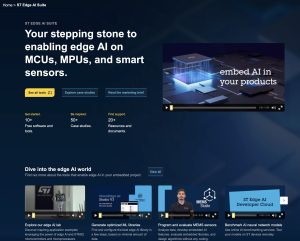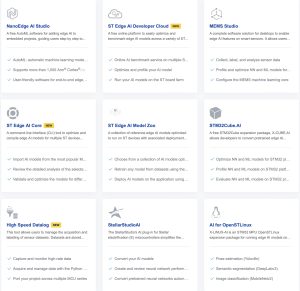To make machine learning at the edge more accessible, ST launched the ST Edge AI Suite, a repository of free software tools, use cases, and documentation to help developers create AI for the Intelligent Edge, regardless of their experience level. The Intelligent Edge is the collection of smart devices, including IoT, industrial, automotive, and personal electronics, with Edge AI capabilities offering new features and better sensor data processing capabilities. This concept extends beyond traditional IoT by incorporating advanced machine learning algorithms on the devices, enabling real-time data processing and decision-making.
ST Edge AI Suite also serves to unify ST’s solutions and help users see how utilities relate to one another. Machine learning can take many forms, from running a small decision tree on a sensor to a more complex neural network on a processor. Needs are also changing as developers expect a model zoo, a board farm to evaluate performance remotely on real systems, and quantization solutions to help with optimization. But the question is always the same: where to begin?
Developers: the new heroes of the Intelligent Edge story

Let’s take the example of a developer looking to create a smart tire pressure monitoring system for a small vehicle. As is very often the case, the idea of monitoring pressure is far from new. Still, the spatial, physical, electrical, and cost constraints demand that the engineers find an original solution rather than sticking a bunch of expensive sensors in numerous places. Looking for inspiration, the developer first explores the case studies in ST Edge AI Suite and finds how Panasonic solved this problem with ST solutions. Armed with the knowledge that an STM32F3 is already doing the trick in a real-world setting, the engineers have the links to learn more and download STM32Cube.AI to get started.
The example above is simplistic, but makes a critical point. According to a recent report by Memfault, the “average IoT product boasts over half a million lines of code.” Nowadays, developers must do a lot more than write basic while loops after initializing a few pins. AI at the edge plays an increasingly important role in embedded systems. Unfortunately, too many underestimate the challenges and complexities associated with bringing machine learning to embedded systems. From the acquisition of training data to the choice of models, the optimizations of the neural network, and its implementation, numerous pitfalls can slow a project to a crawl. To meet this new challenge, Edge AI Suite aims to get developers on the right track.
Edge AI Suite: The secret weapon for AI at the edge

Most developers will appreciate that Edge AI Suite centralizes all our ST tools, especially because machine learning is such a multidisciplinary exercise. No developer should expect to do everything in one software. That’s why we created a suite showcasing all our solutions for data logging, model optimizations, code conversion, benchmarking, deployment, and more. Avid readers of the ST Blog are familiar with many of the tools listed on this page, such as NanoEdge AI Studio, STM32Cube.AI, X-LINUX-AI, MEMS Studio, the Edge AI Developer Cloud, or StellarStudioAI, which we featured in our piece on machine learning in cars. By centralizing these tools, we reduce the barrier to entry by ensuring that even developers with little experience know where to begin.
Additionally, even people familiar with our software will appreciate new utilities, like Edge AI Core, a command-line interface that opens up features from our software to power users. In essence, developers can write scripts to evaluate, optimize, and compile edge AI models for microcontrollers, microprocessors, and sensors. It is thus proof that while we do offer various tools tailored to different products and use cases, we have an underlying foundation that binds all of our work to make the ST ecosystem cohesive. Hence, developers working with our ecosystem get an experience that they can easily port to other projects or products.
Edge AI Suite: The back story of a unified vision
Edge AI Suite recognizes that many developers’ machine-learning journeys are long and varied. That’s why we offer tools like High Speed Datalog, which goes beyond code to help capture and visualize sensor data. There’s even a Python SDK to help manipulate the incoming information. Hence, behind the scenes, ST aims to help engineers start on the right footing. We know very well that data scientists must use frameworks and software outside our ecosystem. The point is not to be the end-all-be-all but to make AI at the edge more accessible by demystifying it.
Similarly, Edge AI Suite also showcases the services and technologies that Authorized ST Partners can bring. For instance, ID3 Technologies provides facial recognition software. Similarly, the ST Blog showcases partners that create machine learning applications at the edge, like 221e and their AI-powered STM32 sensor module. Put simply, Edge AI Suite is more than just a suite but a symbolic initiative highlighting how the ST community and its partners are coming together to make AI at the edge more accessible. Going forward, we can expect a shared vision that will shape our software and greater visibility of Authorized Partners that can help make AI at the edge a reality.




